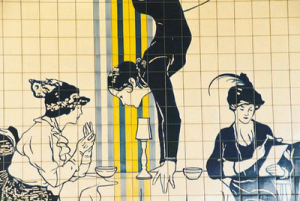
With its long history of azulejaria, or tilework, and decorative calçada, it could be argued that Lisbon’s soul is illustrated along its walls and cobblestones. One of its best known illustrators was multimedia artist Eduardo Nery, who died in Lisbon on March 2, aged 74.
With a writer mother and engineer father, Nery was born in Figueira da Foz and grew up in Lisbon. He attended the Escola Superior de Belas Artes de Lisboa, majoring in painting and also studying architecture and museum conservation. He worked with French tapestry artist Jean Lurçat at Saint-Céré during the 1960s and Nery’s diverse education is reflected in a career that combined photography, painting, glasswork, printmaking, tiles and tapestry and spanned gallery exhibitions and public art commissions.
His major public art commissions ranged from the interiors of suburban shopping centres, such as the Laranjeiro Shopping Center, Almada (1994) and Centro Comercial Riyadh, Cascais (1977), to the painting of a Carris bus (1982-85) and a TAP airplane (1996). Nery’s experimentations with spatial and colour relationships are on display across Portugal but they are particularly notable in the capital.
A characteristic found in several of Nery’s projects is a holistic approach, utilizing not only one surface but when possible, multiple surfaces. A project for the Todos-os-Santos Clinic (1971-73) used painted steel, tempered and mirrored glass for both the exterior and interior spaces. The resulting geometric shapes unify the interior and exterior spaces of the clinic while also echoing the patterns that are commonly found in urban settings, including storefront gates. At the head office of the Caixa Geral de Depósitos (1991-93), an entrance is transformed from floor to ceiling, using concentric circles in the pavers, the stained glass and mosaic tiles that mimic the shape of the cupola.
Historical azulejo forms do make appearances in Nery’s work, but these are often reinterpreted and in some cases, completely broken down. For example, a tile panel made for the Empresa Portuguesa das Águas Livres (EPAL) building (1991) combines monochromatic blue tiles with fragments of 18th century azulejos.

Opened in 1993, Lisbon’s Campo Grande subway station linked two previously separate metro lines and also marked notable shifts in the subway’s construction (with the use of viaducts) as well as the kind of art found within the city’s metro stations built after the 1970s. Nery includes traditional blue and white azulejos but through a very contemporary take on the 18th century figuras de convite, or welcoming figures.
The juxtaposition of the historical with the contemporary also occurs in the redesign of cobblestone pavers at the Praça do Município (1997-98), the plaza that faces Lisbon’s city hall, and its 19th-century, Neoclassical-style façade. It shows the continuation and evolution of an interest in spatiality seen in his early Op-Art tapestries of the 1960s; a spatiality that is useful for a plaza that is not only home to the city’s pelourinho (pillory) but in close proximity to the much larger Praça do Comércio.
In June 2012, Eduardo Nery was recognized as a Grand Officer of the Ordem do Infante D. Henrique by President Aníbal Cavaco Silva.
Leave a Reply
You must be logged in to post a comment.